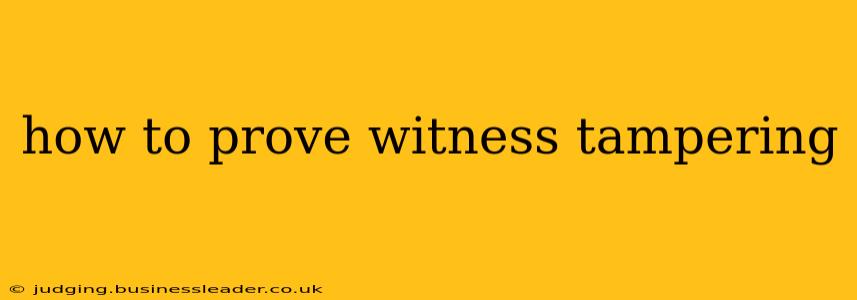How to Prove Witness Tampering: A Comprehensive Guide
Witness tampering is a serious crime, undermining the integrity of the justice system. Proving it requires meticulous evidence gathering and a clear understanding of the legal elements involved. This guide outlines the key steps and considerations in building a successful case.
Understanding Witness Tampering
Before delving into the proof, let's define what constitutes witness tampering. Generally, it involves any attempt to influence a witness's testimony, either directly or indirectly, through intimidation, bribery, threats, or other forms of coercion. The key is that there's an intent to interfere with the witness's ability to truthfully testify in a legal proceeding. The specifics vary by jurisdiction, so consulting with a legal professional is crucial.
What constitutes evidence of witness tampering?
This is a critical question, and the answer depends on the specific actions taken and the available evidence. Here are some common types of evidence used to prove witness tampering:
-
Direct Evidence: This is the most compelling type of evidence. It includes direct statements from the alleged perpetrator admitting to attempting to influence a witness, or recordings of conversations where such attempts are made. Think audio or video recordings, written confessions, or witness testimony describing direct threats or offers of bribes.
-
Circumstantial Evidence: This type of evidence relies on inferences and suggests tampering without direct proof. Examples include:
- Suspicious Contact: Repeated or unusual contact between the alleged perpetrator and the witness after the incident in question. This could be phone calls, emails, texts, or in-person meetings.
- Financial Transactions: Unexplained transfers of money or gifts from the alleged perpetrator to the witness.
- Threats or Intimidation: Evidence of threats, harassment, or intimidation directed at the witness or their family and friends. This could include threatening messages, vandalism, or stalking.
- Witness Recantation: A sudden and unexplained change in a witness’s testimony, particularly if it aligns with the interests of the alleged perpetrator, is highly suspicious.
- Witness Disappearance: If a witness disappears or becomes unreachable, it can be strong circumstantial evidence of tampering.
What are the challenges in proving witness tampering?
Proving witness tampering can be challenging due to:
- Lack of Direct Evidence: Often, tampering attempts are carried out discreetly, making direct evidence scarce.
- Witness Reluctance: Witnesses may be afraid to cooperate due to fear of retaliation.
- He said, she said situations: The credibility of witnesses becomes crucial in the absence of concrete evidence.
How do investigators prove witness tampering?
Investigators use various methods, including:
- Surveillance: Monitoring the alleged perpetrator and the witness to gather evidence of suspicious contact.
- Interviews: Interviewing the witness, other potential witnesses, and the alleged perpetrator.
- Document Review: Examining financial records, communication records (emails, phone calls, texts), and other relevant documents.
- Forensic Analysis: Analyzing digital evidence, such as deleted text messages or emails, to reconstruct the events.
What are some examples of witness tampering?
Examples include:
- Offering a bribe to change a testimony.
- Threatening a witness or their family with physical harm.
- Destroying evidence that could incriminate the defendant.
- Providing false information to a witness.
- Attempting to persuade a witness to forget or misremember facts.
What are the penalties for witness tampering?
Penalties vary by jurisdiction and the severity of the offense but can include significant prison time and substantial fines.
Conclusion:
Proving witness tampering necessitates a thorough investigation, strong evidence gathering, and a clear understanding of the legal elements involved. Building a successful case requires meticulous attention to detail and often involves expert legal counsel. This guide provides an overview, but it is not a substitute for professional legal advice. If you suspect witness tampering, immediately seek the assistance of law enforcement and a qualified attorney.
